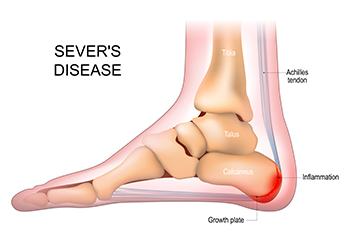Sever’s Disease and Heel Pain

Sever's disease, also known as calcaneal apophysitis, is a common source of heel pain in physically active young individuals, typically emerging during puberty. It occurs more frequently in boys than girls and has no known single cause but likely results from factors like overuse and increased body weight. This condition involves the Achilles tendon's attachment to the heel bone, which is still in the process of changing from cartilage to bone in pre-teens. Symptoms include heel pain during physical activity, worsened pain after exercise, limping, and tiptoeing. Several factors contribute to Sever's disease, including changes in height, weight, increased physical activity volume, type of activity, and footwear choices. Treatment varies based on the level of pain and may include activity modification, load management, heel raises, orthotics, and time for the condition to improve. If your child has heel pain, it is suggested that you make an appointment with a chiropodist for a proper diagnosis and treatment options.
Sever’s disease typically affects young children and teenagers. If your child complains of foot pain, please consult with one of the chiropodists from The Footcare Centre. Our chiropodists will assess your condition and provide you with quality foot and ankle treatment.
What Is Sever’s Disease?
Sever’s disease, also known as calcaneal apophysitis, is an inflammation of the growth plate in the heel bone. It is typically caused by overuse due to repetitive activities such as running, jumping, and playing certain sports. This condition most frequently affects children between the ages of 8 and 14.
Symptoms
Symptoms of Sever’s disease include:
Pain in the back or bottom of the heel
Pain when the sides of the heel are squeezed
Limping or walking on tiptoes to avoid putting pressure on the heel
Difficulty running, jumping, or participating in usual activities
Fatigue
Diagnosis
Sever’s disease is diagnosed by taking a thorough medical history and performing a physical examination. Imaging studies, such as an X-ray, can help rule out other injuries like a fracture.
Treatment
Sever’s disease typically heals without any long-term complications. Treatment involves resting the affected foot by reducing typical activities, wearing orthotics to support the foot, immobilizing the affected foot, taking medications to reduce pain and inflammation, and stretching the foot.
If you have any questions, please feel free to contact our office located in . We offer the newest diagnostic and treatment technologies for all your foot care needs.
